JINR conducts research on frescoes of Moscow Kremlin Cathedral
Media, 16 May 2023
JINR scientists are working together with restorers in the Cathedral of the Dormition of the Moscow Kremlin. As a result, physicists together with art historians will be able to reliably determine what the colours of the frescoes were in reality, carry out their digital reconstruction, and understand exactly how a particular colour changed. In addition, the work will allow specialists to verify procurement documents of the 17th century.
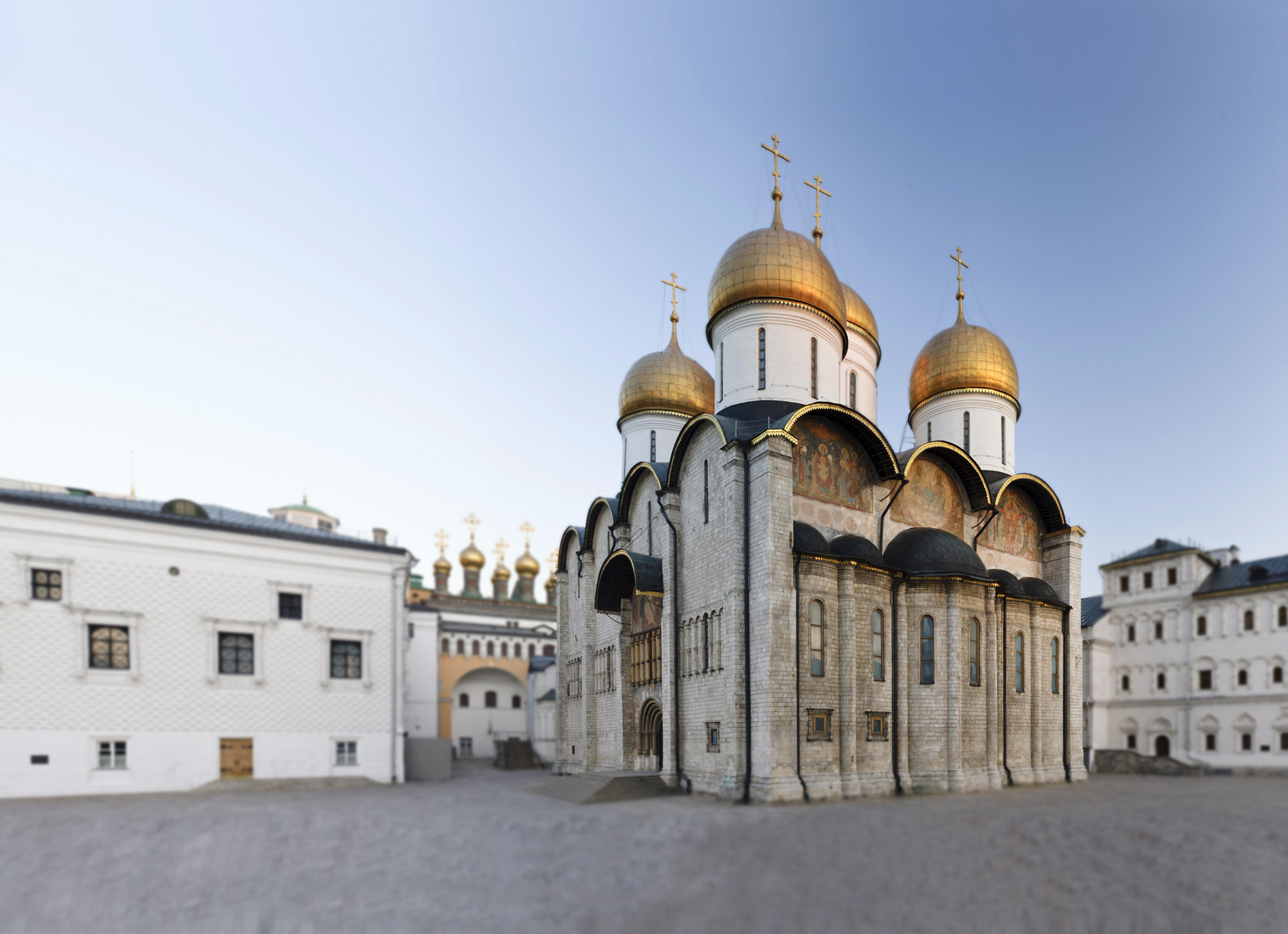 Source: www.kreml.ru
Source: www.kreml.ru
JINR specialists have been researching wall paintings of ancient Russian churches for several years. To carry out all these tasks, leading experts in the field of painting research at the Russian State Research Institute for Restoration trained the staff of the Neutron Activation Analysis Group (NAAG) of the Laboratory of Neutron Physics JINR.
The difficulty of the work is that the restorers of the 19th – early 20th centuries did not strive to preserve the original appearance of frescoes and put new paintings on top of the old ones with modern materials. Today, in the era of scientific restoration, restorers have to provide the results of physical-chemical studies before approving a project in the Ministry of Culture of the Russian Federation. It is done in order to choose the right tools for work, e.g. certain types of solvents that will not spoil the original layer of painting, and to perform restoration as close as possible to the ancient original.
“We have already taken part in the preparation of two restoration projects of the famous Pskov monuments, namely the Transfiguration Cathedral of the Mirozhsky Monastery and the Cathedral of the Nativity of the Mother of God of the Snetogorsky Monastery,” Head of the FLNP Neutron Activation Analysis Group Andrey Dmitriev said.
At the beginning of work at each site, the NAAG staff conducts research using a portable non-destructive X-ray fluorescence analysis (XRF) device. Putting the device on the painting on the wall, they conduct an express analysis of its elemental composition. This allows restorers to determine on the spot what kind of paint was used. For example, red can be based on cinnabar or ochre. Restorers assess the results of the express analysis. Sometimes their result affects the choice of the next point of analysis.
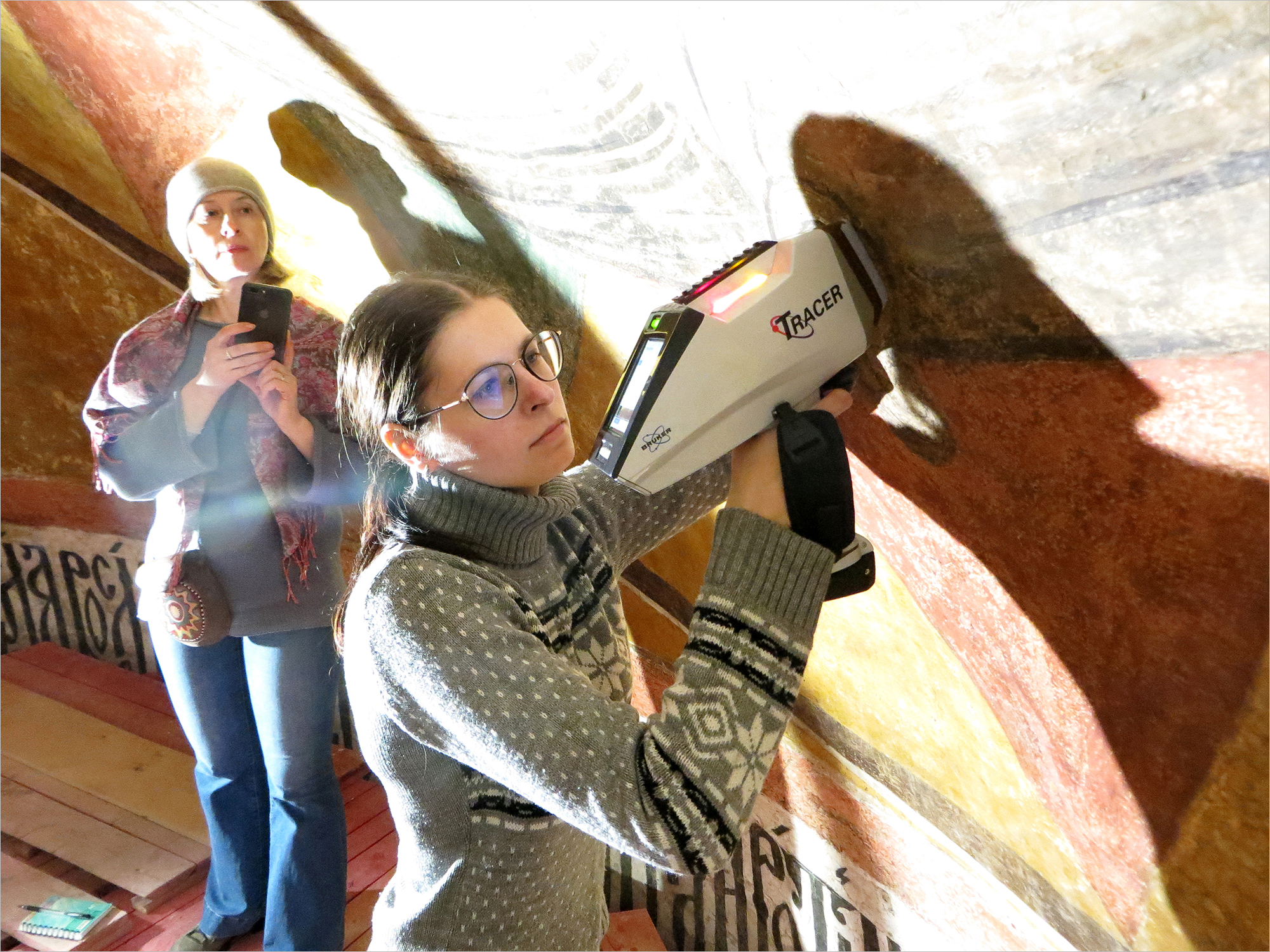 A staff member of NAAG FLNP JINR Natalya Glombotskaya carrying out X-ray fluorescence analysis
A staff member of NAAG FLNP JINR Natalya Glombotskaya carrying out X-ray fluorescence analysis
Besides, in addition to elemental analysis, FLNP JINR scientists use electron microscopy, infrared and Raman spectrometry methods to study frescoes. These methods allow scientists to study painting in layers, find out which molecules the discovered elements are united in, which minerals they are part of.
“Experts at the Cathedral of the Dormition have questions, and the age determination of the gold plating is one of them. We will be able to use our XRF device to determine which century it belongs to by comparing it with known samples of gold plating from different centuries. This is indirect, preliminary dating. And if restorers give us pieces of frescoes for the Laboratory, we will be able to conduct a more detailed study,” a staff member of the Neutron Activation Analysis Group of FLNP JINR Natalya Glombotskaya says. Using stratigraphy, you can see how many and which layers are present in the sample. Polarisation microscopy makes it possible to distinguish pigments by their optical properties. Infrared spectroscopy helps to determine the type of binder. In addition, scientists carry out microchemical analysis in the Laboratory.
Now, the NAAG staff is busy researching the wall painting of 1643 in the Cathedral of the Dormition of the Moscow Kremlin. As a senior researcher of the Moscow Kremlin Museums Olga Zakharova explained, art historians decided to check which of the materials that are known from documents to have been purchased in 1643 by decree of Tsar Mikhail Romanov can be found here. “To understand the composition of the mixtures that form the colorful surface and their relationship to the purchased materials, to verify the documents is a scientific task. The paintings have come with significant losses, and we are now striving to work only with sections of this huge ensemble from 1643,” she said.
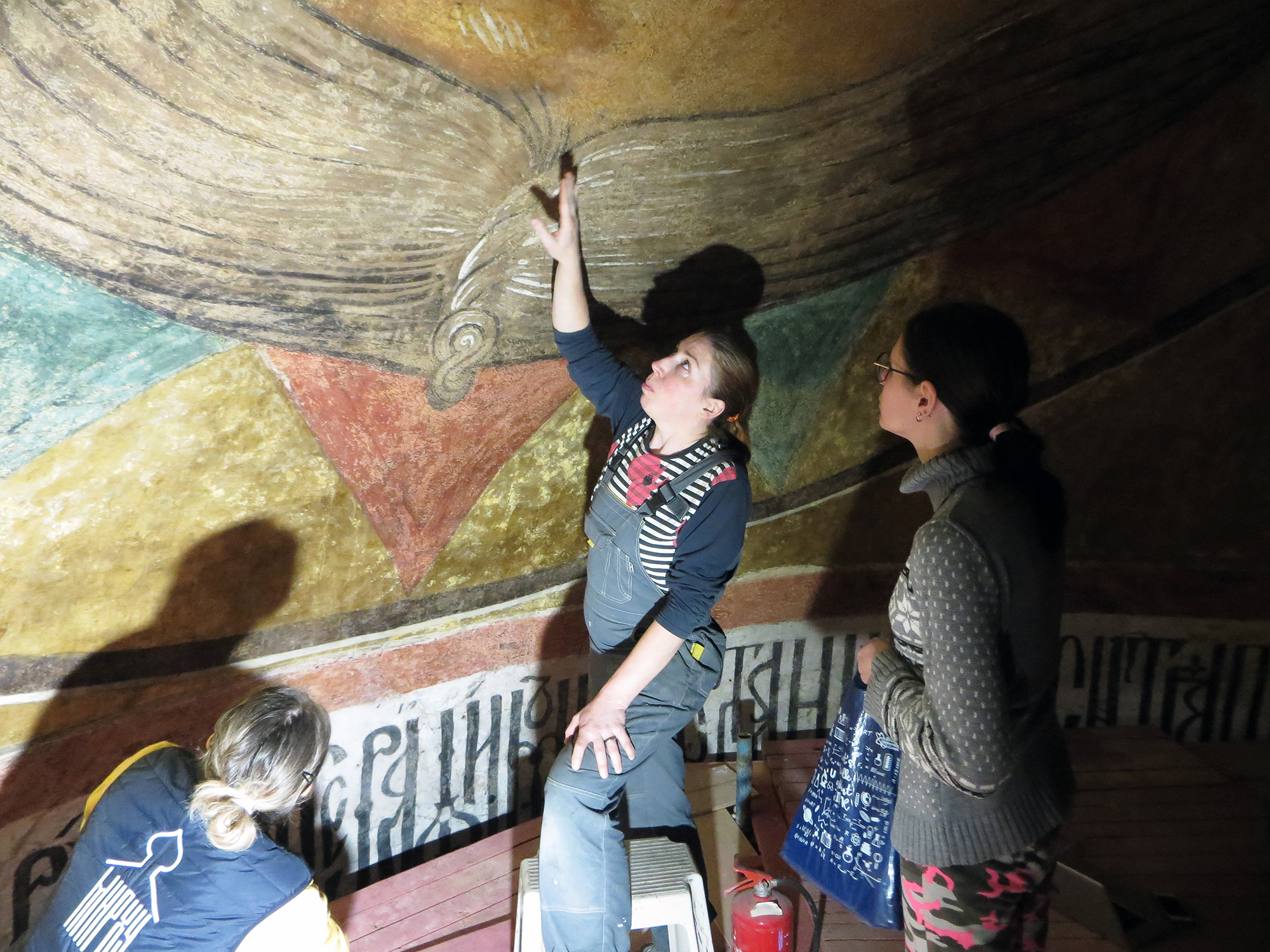 Art restorer of the team named after V. D. Sarabyanova MNRHU Alexandra Grebenshchikovа defining the following point of analysis
Art restorer of the team named after V. D. Sarabyanova MNRHU Alexandra Grebenshchikovа defining the following point of analysis
In the Cathedral of the Dormition of the Moscow Kremlin, the team named after V. D. Sarabyanova of the Interregional Scientific Restoration Art Administration is carrying out the restoration. A restorer of the team Alexandra Grebenshchikova said that at the turn of the 19th – 20th centuries, there was an idea that ancient painting was originally created in dark colours. “Renovators made everything a little gloomy. The painting of the 17th century and all ancient painting in general are bright frescoes, it’s always sunny, radiant,” she highlighted. It turned out that the transition of the colour of the frescoes happened under the influence of factors of temperature, humidity, microorganisms, etc.
“If you enter a church painted by Theophanes the Greek in Veliky Novgorod, you will see that the images are black and red, almost monochrome. Until now, art historians are pondering one question. Is this the author’s ascetic palette or the result of environmental exposure, namely high temperature because of fire, ultraviolet light, humidity, multiple temperature changes from plus to minus? We have tangible results on this topic. First, we conducted a temperature experiment and compiled a scale of temperature transitions of the primary colours. Now we know which colour changes at which temperature. Based on these data, we carry out a digital reconstruction of individual fragments of frescoes and get an approval by art critics. Now we are preparing the first publication on this topic,” Andrey Dmitriev says.
Studies by the NAA group of frescoes depicting three apostles from the Church of St. Simeon the God-Receiver of the Zverin Monastery of Veliky Novgorod showed that under the influence of temperature, yellow ochre turns into red in a few minutes. The chronicle notes that in 1471, when Ivan III conquered Veliky Novgorod, the church “burned”.
“From my point of view, such research results are quite a vivid example of how the humanities and natural sciences are getting along. Our joint activities give remarkable results like this. This is not just a conclusion, but a conclusion supported by a physical-chemical experiment,” Andrey Dmitriev summed up.
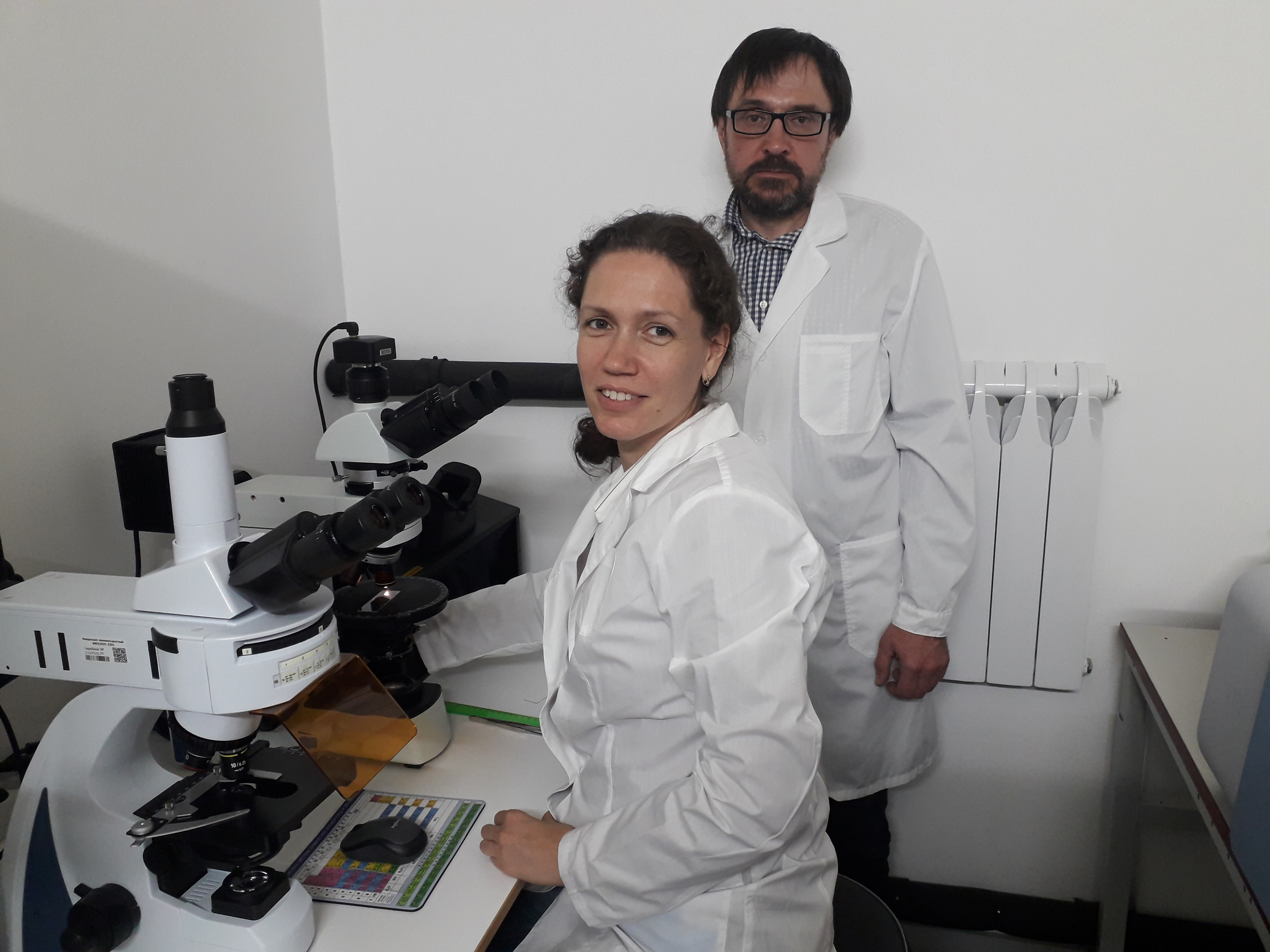 Head of the FLNP JINR Neutron Activation Analysis Group Andrey Dmitriev and a senior researcher of the group Olga Philippova
Head of the FLNP JINR Neutron Activation Analysis Group Andrey Dmitriev and a senior researcher of the group Olga Philippova
A NAAG FLNP JINR senior researcher of the group Olga Philippova gave another example of the transition of colour. “In the drum of the Smolensk Cathedral of the Novodevichy Convent in Moscow, three archangels are depicted in yellow, green, and red clothes. The first two have folds that are drawn in white, and on red clothes the folds are black. When we studied the elemental composition, we found out that there was a lot of lead in these black stripes. Consequently, white lead or lead carbonate was used, not a very stable compound to external influences, i.e. temperature, humidity, some types of bacteria. It eventually turns into almost black lead oxide,” she said. There are plenty of examples of blackened monuments in Europe, Georgia, and Russia. In this case, the FLNP staff showed that there were changed white lead in the black folds on the red clothes, and the white folds on the clothes of other colours were painted with stable lime white. “Based on the obtained data, we reconstructed a fragment of the fresco. As a result of it, we demonstrated that clothes of all the colours were originally depicted in the same style,” the scientist added.
Another work of the group’s staff members is related to the transition of colour. Currently, the cloak on the fresco of Saint George from the 12th century Cathedral of St. George’s Monastery in Veliky Novgorod is black and brown, and in places red colour appears on it. As a result of the study of the elemental composition of the fresco, scientists found a significant lead content. Art historians announced that the cloak of St. George in painting was always painted bright red. As a result, scientists concluded that the decayed lead white darkened the red colour of the cloak.
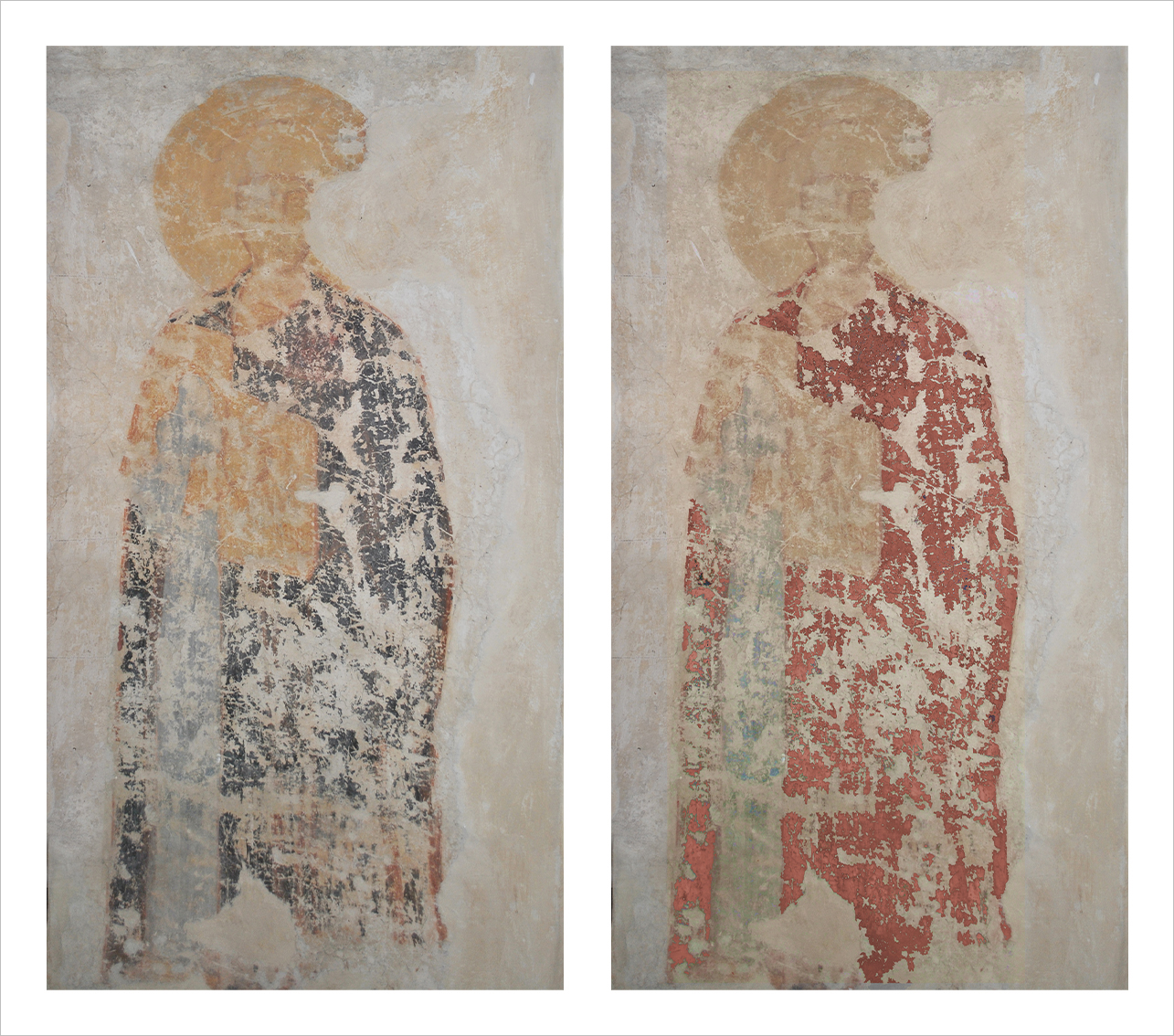 Reconstruction of the colour of St. George’s cloak
Reconstruction of the colour of St. George’s cloak
There is another story connected with Saint George’s Cathedral. The frescoes of the 12th century were preserved in the cathedral until the 19th century. Afterwards it was decided to replace them by removing the old frescoes from the walls and using them as a filler for a new floor. Not so long ago, the floor was opened. Renovators found tens of thousands of fragments of frescoes of different sizes. Some frescoes are so big that the whole face of the saint fits on them. “Now, the find is in the hands of restorers. They are engaged in the restoration of fresco compositions. We took part in the work with these frescoes and discovered that nothing but lazurite was used as the blue colour,” Andrey Dmitriev noted. In those days lazurite was mined only in one place, in Badakhshan, modern Afghanistan, and it was very expensive. The presence of lazurite in medieval monuments gives art historians the right to make assumptions, for example, about the status of painting customers. “We have studied the experience of European colleagues of working with lazurite. So, for example, in Italy, in one of the churches in the south of the country, lazurite was used only in iconic frescoes. Either “false blue”, white lead with charcoal, or azurite was used for the background. There is a huge amount of lazurite in Saint George’s Cathedral. It was used even in background paintings! The results of this study were published in the Heritage Science1 journal,” the scientist said.
Lazurite was also discovered in the St. Sophia Cathedral of the Novgorod Kremlin, in the Transfiguration Cathedral of the Mirozhsky Monastery, and other churches. These are cultural monuments not just of federal significance, but from the UNESCO list.
In 2021, after the first joint work as part of the restoration of the unique wall painting of the 12th century of the Transfiguration Cathedral of the Mirozhsky Monastery (Pskov), the leaders of the Interregional Scientific Restoration Art Administration sent a letter of thanks to JINR. In particular, it said, “… we express our gratitude to JINR for conducting physical-chemical research… The methodology applied by JINR employees brought the knowledge about frescoes to a fundamentally new level. It allowed us to most fully see the picture of the processes taking place in painting”.
The work with cultural heritage objects in FLNP began with the study of the origin of fragments of glass bracelets found in the excavations of the Dubna settlement. In 2019, JINR hosted the first international workshop “Application of nuclear physics methods for the study of cultural heritage objects”. A Doctor of Art History, employee of the State Institute for Art Studies Tatiana Tsarevskaya took part in it. Her report was devoted to the problem of the rebirth of the colour of fresco painting. She brought some fragments of frescoes. Back then the NAA method was first applied in Russia to study the elemental composition of plaster bases of wall paintings. The research was carried out at the IREN Facility and at the IBR-2 Reactor. Now, while the reactor is stopped, scientists are carrying out neutron activation analysis of samples at the Institute of Nuclear Physics of Kazakhstan.
Other materials on the topic:
Work of JINR scientists highly appreciated by art experts
JINR scientists study fresco painting in Trinity Sergius Lavra
- Philippova O. S., Dmitriev A. Yu., Tsarevskaya T. J., Dmitrieva S. O. Comprehensive study of 12th century wall painting fragments from the St. George Cathedral of the Yuryev Monastery in Veliky Novgorod (Russia) using complementary physico-chemical methods. Herit Sci. 2022;10.